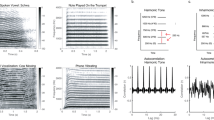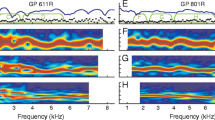Abstract
Harmonics of moderate-level single tones can be measured in the earcanals of gerbils with healthy ears. The same harmonic components measured in a cavity are as much as 20 to 40 dB below those measured in the earcanal. Earcanal harmonics, specifically the second and third, are generated largely within the cochlea and are physiologically vulnerable. Harmonic magnitudes rapidly decrease for primary frequencies above about 3 kHz. High-frequency masking tones can have dramatic suppression effects on the harmonic structure of low frequency primaries. For example, a 2 or 4 kHz masker at moderate levels can totally suppress the third harmonic of a 200 Hz tone. Many of these results can be simulated by a vector-sum model. In this model harmonic emissions can be thought of as very gross potentials that convey little information concerning specific regions of the cochlea.
Access this chapter
Tax calculation will be finalised at checkout
Purchases are for personal use only
Preview
Unable to display preview. Download preview PDF.
Similar content being viewed by others
References
Anderson, S. D. and Kemp, D. T. “The evoked cochlear mechanical response in laboratory primates.” Arch. Otorhinolaryngol. 224, pp. 47–54, 1979.
Kim, D. O. “Cochlear mechanics: implications of electrophysiological and acoustical observations.” Hear Res. 2, pp. 297–317, 1980.
Kim, D. O., Molnar, C. E., Matthews, J. W. “Cochlear mechanics: nonlinear behavior in two-tone responses as reflected in cochlear-nerve-fiber responses and in ear-canal sound pressure.” J. Acoust. Soc. Am. 67, pp. 1704–1721, 1980.
Kemp, D. T. “Stimulated acoustic emissions from within the human auditory system.” J. Acoust. Soc. Am. 64, pp. 1386–1391, 1978.
Schmiedt, R. A. “Acoustic injury and the physiology of hearing.” J. Acoust. Soc. Am. 76, pp. 1293–1317, 1984.
Schmiedt, R. A. and Zwislocki, J. J. “Comparison of sound-transmission and cochlear-microphonic characteristics in mongolian gerbil and guinea pig.” J. Acoust. Soc. Am. 61, pp. 133–149, 1977.
Schmiedt, R. A. and Adams, J. C. “Stimulated acoustic emissions in the ear canal of the gerbil.” Hearing Res. 5, pp. 295–305, 1981.
Schroeder, M. R. “Relation between critical bands in hearing and the phase characteristics of cubic difference tones.” J. Acoust. Soc. Am. 46, pp. 1488–1492, 1969.
Siegel, J. H. and Kim, D. O. “Cochlear biomechanics: vulnerability to acoustic trauma and other alternations as seen in neural responses and ear-canal sound pressure.” In New Perspectives on Noise-Induced Hearing Loss, Ed. by R. Hamernik, D. Henderson, and R. Salvi, Raven press, New York, pp. 137–152, 1982.
Siegel, J. H., Kim, D. O., and Molnar, C. E. “Effects of altering organ of Corti on cochlear distortion products f2-f1 and 2f1-f2.” J. Neurophysiol. 47, pp. 303–328, 1982.
Smoorenburg, G.F. “Combination tones and their origin.” J. Acoust. Soc. Am. 52, pp. 615–632, 1972.
Whitfield, I. C. and Ross, H. F. “Cochlear-microphonic and summating potentials and the outputs of individual hair-cell generators.” J. Acoust. Soc. Am. 38, pp. 126–131, 1965.
Zurek, P. M. “Spontaneous narrowband acoustic signals emitted by human ears.” J. Acoust. Soc. Am. 69, pp. 514–523, 1981.
Zwicker, E. “Nonmonotonic behaviour of (2f1-f2) explained by a saturation-feedback model.” Hearing Res. 2, pp. 513–518, 1980.
Author information
Authors and Affiliations
Editor information
Editors and Affiliations
Rights and permissions
Copyright information
© 1986 Springer-Verlag Berlin Heidelberg
About this paper
Cite this paper
Schmiedt, R.A. (1986). Harmonic Acoustic Emissions in the Earcanal Generated by Single Tones: Experiments and a Model. In: Allen, J.B., Hall, J.L., Hubbard, A.E., Neely, S.T., Tubis, A. (eds) Peripheral Auditory Mechanisms. Lecture Notes in Biomathematics, vol 64. Springer, Berlin, Heidelberg. https://doi.org/10.1007/978-3-642-50038-1_41
Download citation
DOI: https://doi.org/10.1007/978-3-642-50038-1_41
Publisher Name: Springer, Berlin, Heidelberg
Print ISBN: 978-3-540-16095-3
Online ISBN: 978-3-642-50038-1
eBook Packages: Springer Book Archive




